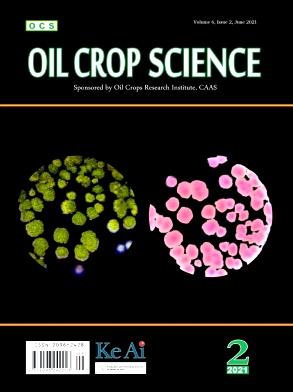芝麻(Sesamum indicum L.)育种性状基因及qtl发现综述
Q3 Agricultural and Biological Sciences
引用次数: 0
摘要
芝麻是一种多用途、高价值的油料作物,可用于食品、饲料、化妆品等领域。芝麻的低产量是由于缺乏高产和地方适应的品种,这些品种对蒴果破碎和生物和非生物胁迫敏感。与油菜籽、花生和向日葵等其他油料作物相比,芝麻的育种收益低且停滞不前。培育与产量相关、油的数量和质量、生物和非生物胁迫耐受性增强的品种对适应气候变化至关重要。利用现代植物育种工具,已经鉴定出与芝麻产量相关、油脂数量和品质、生物和非生物胁迫耐受性相关的几个基因和数量性状位点(qtl)。深入了解芝麻产量相关、油脂数量和品质、生物和非生物胁迫耐受性的遗传基础、分子机制和调控基因,对改进芝麻育种计划具有重要意义。本文对这些研究成果进行综述和整理,为芝麻的实际应用研究提供基础数据和参考。本文章由计算机程序翻译,如有差异,请以英文原文为准。
Genes and QTLs discovery for sesame (Sesamum indicum L.) breeding traits: A review
Sesame is a multi-purpose high-value oilseed crop, which can beused in the food, feed, and cosmetics applications. The low yield of sesame is due to the lack of high-yielding and locally adapted varieties, which have the susceptibility to capsule shattering and biotic and abiotic stresses. The breeding gains in sesame are low and stagnant compared to other oilseed crops such as canola, groundnut and sunflower. Breeding for enhanced yield-related, oil quantity and quality, biotic and abiotic stresses tolerant varieties is vital to the adaptation of the climate change. Several genes and quantitative trait loci (QTLs) related to yield-related, oil quantity and quality, biotic and abiotic stresses tolerant have been identified through modern plant breeding tools in sesame. The depth understanding of the genetic basis, molecular mechanisms and regulatory genes involved in yield-related, oil quantity and quality, biotic and abiotic stresses tolerant in sesame is important for the improvement of sesame breeding programs. This article reviews and documents these achievements will provide fundamental data and references for practical applications of sesam research.
求助全文
通过发布文献求助,成功后即可免费获取论文全文。
去求助
来源期刊

Oil Crop Science
Food Science, Plant Science, Agronomy and Crop Science
CiteScore
3.40
自引率
0.00%
发文量
20
审稿时长
74 days
 求助内容:
求助内容: 应助结果提醒方式:
应助结果提醒方式:


